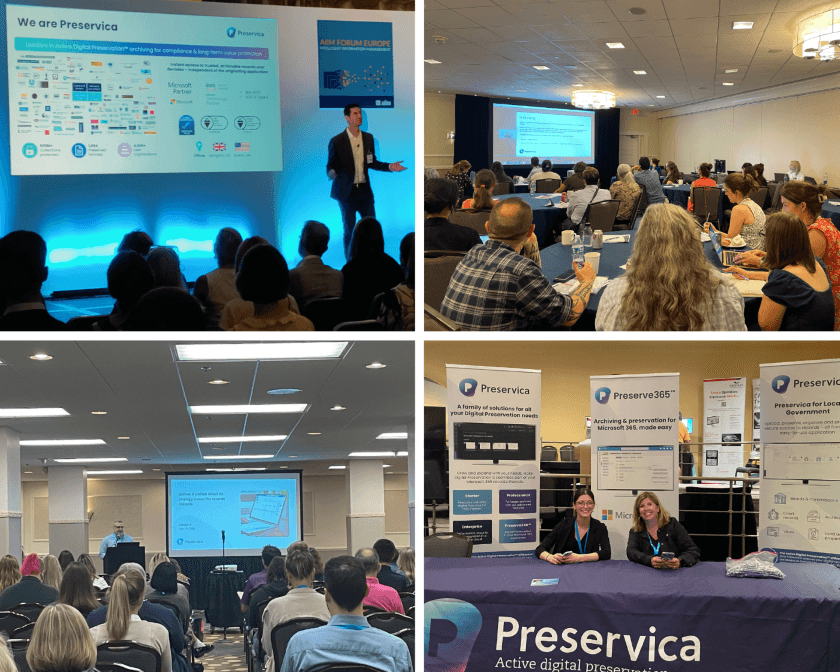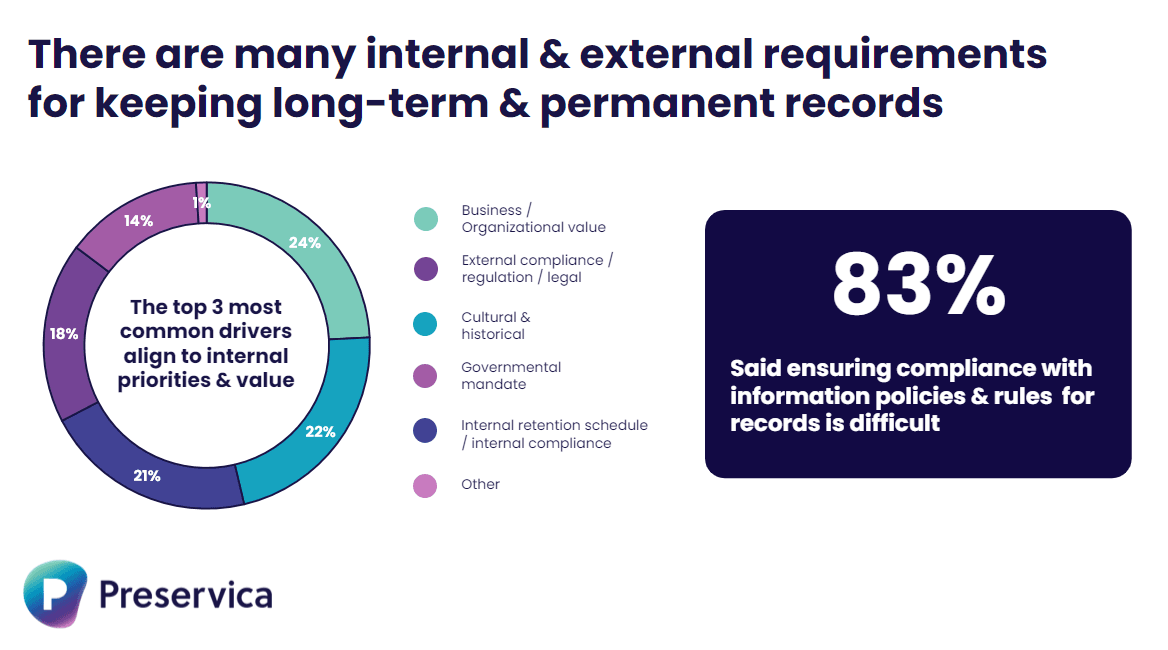Unlocking the future of records management with Preserve365® and key trends from the 2023 conference season

Since its launch in May, Preserve365® is demonstrating its ability to simplify long-term Microsoft 365 record governance and archiving. By integrating Preservica's Active Digital Preservation™ technology, it disrupts traditional archiving approaches.
During this time, the Preservica team has been busy attending numerous conferences, engaging with industry thought leaders, solution partners and various practitioners. From MER (Chicago) and NAGARA (Cincinnati) to the AIIM Forum Europe (London) and IRMS (Manchester, UK), these gatherings are instrumental in shaping the future of electronic records life-cycle management.
We had the pleasure of showcasing Preserve365®’s groundbreaking solution to a diverse audience at these events, including records managers and information governance providers hailing from government, corporate and legal sectors.

Several conversations and innovative ideas were exchanged. During these interactions, we discerned a series of recurring themes that shed light on the effective management and safeguarding of long-term records within the Microsoft 365 ecosystem.
Let's delve into the challenges industry professionals are currently facing and explore the recurring themes that emerged from our conversations both at the conference and in our Preserve365® Early Access Group (EAG).
Industry Professionals Seek Modern, Device-Compatible Solutions
Conference attendees were consistently describing challenges with their current record management systems. These industry professionals describe the limitations of manual processes and the absence of cross-device compatibility, which restrict their utilization of familiar tools in today's digital environment.
These sentiments align with the participants in the Preserve365® Early Access Group (EAG) who feel that although automated governance capabilities exist in Microsoft 365, the majority of them still rely on manual methods for the continued accessibility of long-term information. This leads to further concerns about staff resorting to external sources for information, which results in more workflow inefficiencies.
Current Trends: Understanding the Massive Scale of Data in Microsoft 365
Microsoft is the preferred choice over external database providers because of its reputation for reliability, convenience and seamless integration, especially when it comes to maintaining up-to-date systems. This comprehensive suite of cloud-based productivity tools and services offers a robust solution to effectively manage and navigate the three V’s: volume, velocity, and variety of data.
The volume of records being generated in Microsoft 365 is already massive, with $1.4 billion monthly active devices running Windows 10 or 11, over 1 million companies using Microsoft 365, and more than 1.6 billion documents being added to Microsoft 365 every day. The volume will only continue to grow, creating a virtual rising tide, or information tsunami that must be protected for future generations.
In the next two to three years, the amount of data flowing into Microsoft 365 is projected to increase by 4.4 times compared to current levels. As previously mentioned, a staggering 88% of organizations continue to rely on manual methods for handling this influx despite this anticipated surge. Similarly, the same percentage of organizations find it challenging to effectively manage compliance with information policies and rules for records.
Records managers say at least 25% of their records have greater than seven years of retention or are permanent. This underscores why the need for new automated tools to protect and future-proof high-value content has never been greater for compliance and regulation.
Overcoming Barriers to Compliance and How to Navigate Them
With 83% of our Preserve365® EAG reporting that efficient and permissible access to archived records is important to them, the top three common drivers for keeping long-term and permanent records were: business value, cultural and historical value and internal retention schedule & internal compliance.
With that, there are common barriers to compliance in records management. Here are the top 5:
- Overwhelming Volume: Dealing with a vast amount of records spread across different locations and with varying complexities makes effective management and compliance enforcement challenging.
- Lack of Time, Skills, and Knowledge: Resource constraints and competing priorities often result in organizations struggling to allocate sufficient attention and expertise to proper records management.
- Information Hoarding: The tendency to retain everything without proper evaluation or disposal leads to an unwieldy and unmanageable records landscape.
- Inadequate Tools and Systems: Reliance on file shares and the absence of specialized record management technologies hinder compliance efforts.
- Changes in Systems and Technologies: Frequent updates and shifts in information management platforms can disrupt compliance practices, requiring organizations to continuously adapt and stay current.

The continued accessibility of long-term information is at risk and needs managing for the full lifecycle. Readability, trustworthiness, and discoverability are the top risks to information governance relying on disparate systems. Other risks include:
Unintended access & deletions
Incomplete metadata & uncomplete context
Unclear ownership & provenance
Corrupted files
Obsolete or unmanaged file formats
No software license or vendor support
Lossy conversions
These digital risks are closely intertwined with compliance risks, particularly when it comes to retaining long-term records for compliance purposes. The inherent danger lies in the possibility that these records may not be retrievable when they are needed, with regulations such as the Freedom of Information Act (FOIA) and other legal retention requirements.
This risk becomes apparent when long-term and permanent digital records are scattered across various systems, including content and document management systems like SharePoint, shared drives, physical media like CDs, cloud archives, third-party information archiving software, websites and platforms like YouTube and Flickr. This fragmentation increases the likelihood of non-compliance, especially concerning social care records, decision-making processes, infrastructure planning and other long-term and permanent records.
The challenge encompasses existing digital records accumulated over 40+ years, with the future introduction of unknown formats such as 3D, virtual reality (VR) and ChatGPT.
That’s where Digital Preservation is setting a new standard. But is it really that simple? The answer is yes.
Preserve365® is simplifying compliance by making the archiving and retrieval of high-value long-term records an embedded part of the Microsoft 365 experience. Users of all expertise levels can migrate the growing amount of Microsoft content into readable formats, ensuring its preservation and accessibility for the next 100 years. This means that crucial data can be captured, protected and accessible for generations to come — a true investment in your organization’s future.
With Preserve365®, users can:
Streamline and implement a unified information governance strategy
Maximize efficiency for businesses by integrating their archiving and search needs
Preserve high-value information while maintaining compliance
Eliminate the requirement for separate vendor-specific tools
Preservica is eagerly looking forward to continuing the conversation during the fall conference season, starting with ARMA in Detroit, followed by RIMPA in Australia. We can't wait to further engage with industry experts and explore innovative approaches to managing and preserving records for the future. Stay tuned as we continue to explore the frontiers of information governance, fueled by Preserve365®'s capabilities.
Preserve365® is now in Preview. Click here to Join our Preview group.




